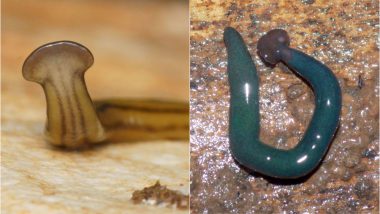After almost 20 years, five invasive species of Giant Hammerhead flatworms, native to tropical Asia, have been detected in parts of France and in French territories, according to a new study collecting reports of sightings dating back to 1999. The squishy invaders have been infiltrating French ecosystems and preying on small, soil-dwelling creatures. Though the worms were first spotted decades ago, this is the first study to investigate the extent of their invasion and to question what it might mean for the ecosystems that they overrun.
The giant hammerhead flatworms are muscular, colourful bodies topped with elongated heads resembling those of hammerhead sharks. The worms can measure more than one foot in length and they occupy a range of ecosystems on land, gobbling up earthworms and other prey. They have another peculiar feature – regeneration. When bits of them are amputated, these bits can regrow into complete worms. Lead study author Jean-Lou Justine, a professor with the Department of Systematics and Evolution at the National Museum of Natural History in Paris, said that these flatworms can be introduced to foreign habitats as soil stowaways in international plant shipments.
Over four years, Justine and his colleagues investigated 111 records and observations gathered by volunteers from sightings in gardens from 1999 to 2017. Two out of the five flatworm species are likely to be newfound species – the black Diversibipalium genus and one an iridescent blue, found on the island of Mayotte.
In the study, scientists report two reasons why they are such successful invaders. One reason is that these giant flatworms can reproduce asexually, which enables a single individual to produce many offspring immediately. “Another reason is the absence of predators,” Justine added. “Land flatworms produce chemicals that give them an unpleasant taste,” so predators avoid eating the worms.
The flatworms have been showing up where they shouldn’t be since at least 1999 that amazed the authors that there was so little published research about the invaders prior to this investigation. The scientific authorities have yet to evaluate the impact of the worms’ invasive habits on native ecosystems. Flatworms prey on organisms that live in soil, which could affect soil ecology and the life cycles of plants, Justine said. “As invasive predators, giant flatworms are likely to be a threat to the abundance and biodiversity of the soil invertebrates,” he said.
(The above story first appeared on LatestLY on May 25, 2018 10:03 AM IST. For more news and updates on politics, world, sports, entertainment and lifestyle, log on to our website latestly.com).













 Quickly
Quickly


